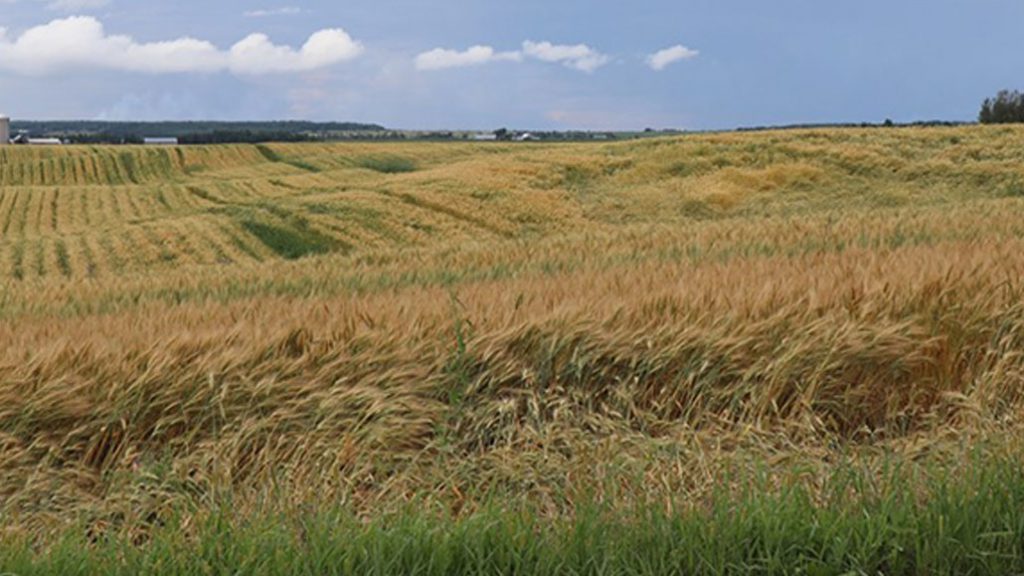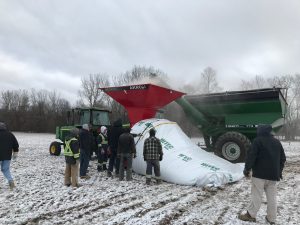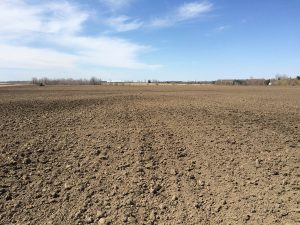Preventing lodging in milled oats
EARLY RESEARCH OBSERVATIONS

CROP QUALITY, YIELD potential, and susceptibility to lodging can have significant impacts on the profitability of milled oats — a crop common to Northern Ontario, and one to which food processors mandate a high standard.
Researchers with the University of Guelph and the Ontario Ministry of Agriculture, Food and Rural Affairs (OMAFRA) — with support from Grain Farmers of Ontario, Syngenta, and PepsiCo (the owner of Quaker Oats) — are now trying to determine what approaches best support yield and quality, while also determining which makes for the most economical production.
The research project is now in its second of two years, and after a season featuring particularly severe lodging damage, early observations appear to highlight the importance of variety selection, as well as a need to focus on root rather than stem integrity.
| KEY OBSERVATIONS • Lodging susceptibility is heavily related to variety selection. • Deep seeding did not appear to impact yield. • Under the conditions observed in the 2020 trial year, lodging issues appear to be related to weak roots, not stems. The tendency to plant shallow for better emergence could be a contributing factor. |
LODGING
Lodging can have significant yield consequences for milled oats, says Joshua Nasielski, assistant plant science professor at the university and one of the project’s main researchers. It’s a problem which is often amplified by higher yields, fungal diseases, and when in-season lodging occurs.
“Yield losses of 15 to 30 per cent are not unrealistic,” Nasielski says. “It can also happen really closer to harvest where you’re not getting as much of a yield hit, but it can be difficult to combine. There are certain heads that make it easier, but certainly makes it more difficult.”
He adds the impact of lodging on quality is itself a major consideration, with the potential to lose as much as $30 per acre in buyer premiums. Better understanding how to prevent crop collapse is thus critical.
The overall project objective, Nasielski says, is to identify what combinations of seeding rate, planting depth, and row spacing push yields while reducing lodging risk. A wide spectrum of these metrics, along with different nitrogen application rates and timings, are currently being analyzed. A plant growth regulator is also being tested in combination with these factors.
Field trials were conducted at the Winchester and New Liskeard Ontario Crop Research Centres. These included somewhat extreme cases in order to better contrast the impact of specific management techniques in more standard in-field practices. This includes applying nitrogen at late growth stages (at flowering and stem-longation specifically), and seeding up to three inches deep.
With particular reference to nitrogen application rates, Nasielski reiterates they also hope to identify how to offset costs for the greatest production efficiency.
ROOTS AND GENETICS
Data from the first year is still being analyzed at the time of this writing. However, Nasielski says several notable observations were made in-season.
Seeding at a depth of three inches did not appear to have a significant impact on yield or lodging. Indeed, Nasielski says he was surprised this was the case given its relative extremity to conventional, shallower seeding practices.
Variety selection was another noticeable consideration.
“Regardless of management, variety was a huge factor,” he says, adding three different varieties were included in field trials. “That’s probably the one I’m most confident about. That may not be the most surprising thing, but that’s what’s coming out of the data.”
Critically, a prevalence of lodging due to root weakness — rather than stem weakness — was also observed.
“Very little stem lodging was found. So, in Ontario, it appears that root anchorage failure, as opposed to stem bending, is responsible for lodging in oats,” says Nasielski.
“This makes sense based on past work, and implies management that increases the strength of the soil-root system is required to reduce lodging. Plant growth regulators are often marketed as ‘stem stiffeners’ but the initial data suggests they have an impact on root anchorage strength.”
More concrete observations on the impact of specific management practices are forthcoming in 2021 and 2022.
This project was funded in part by the Ontario Agri-Food Innovation Alliance, a collaboration between the government of Ontario and the University of Guelph.
Disclosure and disclaimer: This research was funded by PepsiCo R&D. The views expressed in this article are those of the author and do not necessarily reflect the position or policy of PepsiCo, Inc.
This article feature research funded by Grain Farmers of Ontario. •



























